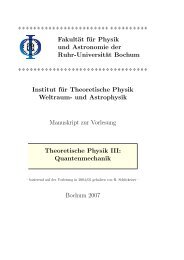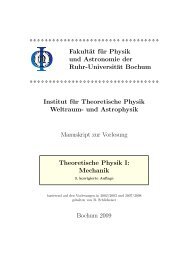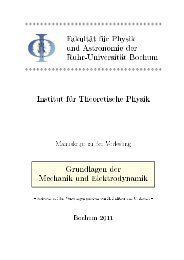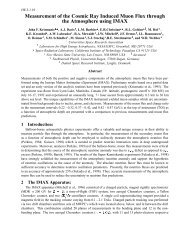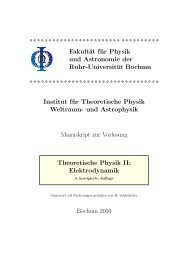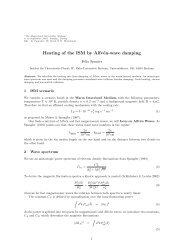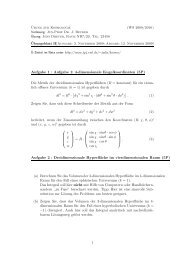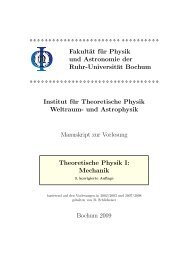pdf here - Theoretische Physik IV - Ruhr-Universität Bochum
pdf here - Theoretische Physik IV - Ruhr-Universität Bochum
pdf here - Theoretische Physik IV - Ruhr-Universität Bochum
You also want an ePaper? Increase the reach of your titles
YUMPU automatically turns print PDFs into web optimized ePapers that Google loves.
We shall assume that the ions are Boltzmann distributed and their ion number density is<br />
n i = exp( i '): (5)<br />
This choice, though seemingly counter-intuitive, is motivated by accretion disk plasma gas<br />
models [19], w<strong>here</strong> the ions are reported to be up to 300 times hotter than the electrons (a<br />
more conventional …xed-ion hypothesis may also be adopted, upon simply setting i = 0,<br />
viz. n i = constant, in the forthcoming algebra). In (1)-(5), r and are the radial and<br />
polar angle coordinates, n e(p) and n i are the number densities of electrons (positrons) and<br />
ions, respectively, u e(p) and v e(p) are the electron (positron) velocities in the r and directions,<br />
respectively and ' is the electrostatic potential. The time and space variables,<br />
t and r; are normalized by the electron plasma period ! 1<br />
pe<br />
[= (4e 2 n e0 =m) 1=2 ] and the<br />
electron Debye radius De [= (T e =4e 2 n e0 ) 1=2 ], respectively. The densities n e=p=i , velocities<br />
(u e=p ; v e=p ) and electrostatic potential ' are normalized by the unperturbed equilibrium number<br />
electron density n e0 , the electron thermal speed C de [= (T e =m) 1=2 ] and T e =e, respectively<br />
(Boltzmann’s constant is omitted everyw<strong>here</strong>). We have denoted e = 1 for the electrons,<br />
p = T p =T e for the positrons and i = T e =T i for the positive ions. Finally, we have de…ned<br />
the dimensionless parameters q e =<br />
The quasi-neutrality condition at equilibrium reads<br />
1 (for the electrons) and q p = 1 (for the positrons).<br />
+ = 1 ; (6)<br />
w<strong>here</strong> = n i0 =n e0 and = n p0 =n e0 denote the ion-to-electron and positron-to-electron<br />
unperturbed density ratio(s).<br />
III.<br />
QUASI-CONCENTRIC NONLINEAR WAVE PROPAGATION - DER<strong>IV</strong>A-<br />
TION OF THE CYLINDRICAL KADOMTSEV-PETVIASHVILI EQUATION<br />
In view of investigating the nonlinear propagation of the electrostatic waves, we shall<br />
employ a reductive perturbation technique [20, 21]. We anticipate excitations with nearly<br />
cylindrical symmetry, so the angle subtended by the wavefront in the nearly-concentric case<br />
may be assumed to be small. The independent variables can be stretched as<br />
= " 1=2 (r t); = " 1=2 ; and = " 3=2 t; (7)<br />
5



